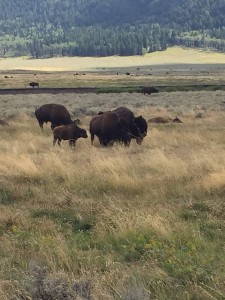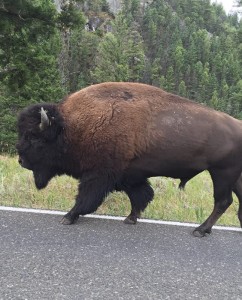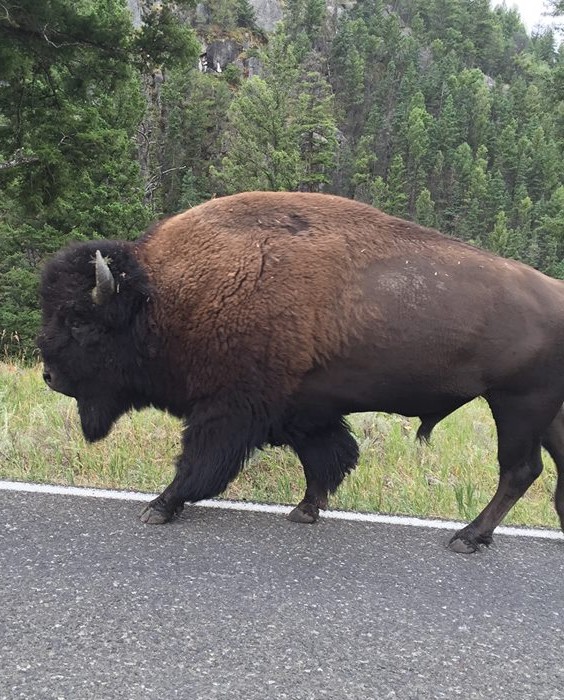 As Autumn arrives, we have a chance to reflect upon the passing Summer. Here in the US, warm weather and kids out of school conspire during this season to bring about one of our long-held cultural rituals: Summer Vacation! Now, before traveling down the path of considering vacation (a period of suspension of work, study, or other activity, usually used for rest, recreation, or travel; recess or holiday) as an indulgence of western culture, we learned on a trip to the Amazon that villagers occasionally travel with their families deeper into the jungle for brief periods to escape the stresses of village life, fish and relax. Digression aside, this year my family took our annual trip to Pine Ridge, SD, then seized an opportunity to spend some time on the road camping and visiting some of the remarkable lands (and sea) of the western US. One of these early stops included Yellowstone National Park, considered by some to be the Serengeti of North America due to its diverse array of visible wildlife and impressive geysers and land formations. The sites did not disappoint – but the tourists…and the culture of tourism.
As Autumn arrives, we have a chance to reflect upon the passing Summer. Here in the US, warm weather and kids out of school conspire during this season to bring about one of our long-held cultural rituals: Summer Vacation! Now, before traveling down the path of considering vacation (a period of suspension of work, study, or other activity, usually used for rest, recreation, or travel; recess or holiday) as an indulgence of western culture, we learned on a trip to the Amazon that villagers occasionally travel with their families deeper into the jungle for brief periods to escape the stresses of village life, fish and relax. Digression aside, this year my family took our annual trip to Pine Ridge, SD, then seized an opportunity to spend some time on the road camping and visiting some of the remarkable lands (and sea) of the western US. One of these early stops included Yellowstone National Park, considered by some to be the Serengeti of North America due to its diverse array of visible wildlife and impressive geysers and land formations. The sites did not disappoint – but the tourists…and the culture of tourism.
When I say “culture of tourism”, I am referring to the sense of not belonging, of passing through without feeling responsible for the improved well-being of the land and people that welcome you as a guest. Extracting experience without exchanging a meaningful contribution, and sometimes not even respecting the hospitality. So, we found ourselves in the tourist sea, taking in sites and experience without feeling or finding a meaningful connection or contribution. What led our national parks to be paved with this kind of cultural experience? Well, a little digging and we find that the history of “pristine” and protected areas is born out of a mindset that believes that humans have little, if anything to contribute to the benefit of the natural world. We can see it, look at it, but interact with it as little as possible or we will mess it up.
 Indeed, humans are terraformers, we’ve been shaping our world since as long as we have walked this earth. We have done it well and we have done it poorly. One of the key shifts we must make is in returning to see humans as a part of nature, not separate from it, and to learn from the Indigenous populations that have co-evolved upon this earth for millennia so that we may regenerate places around the planet. In National Parks, a historical look back reveals how our dominant world view evicted those best suited to manage it, then brought them back in for display to tourists. As the article below points out, this history continues to live today in “conservation” efforts around the world.
Indeed, humans are terraformers, we’ve been shaping our world since as long as we have walked this earth. We have done it well and we have done it poorly. One of the key shifts we must make is in returning to see humans as a part of nature, not separate from it, and to learn from the Indigenous populations that have co-evolved upon this earth for millennia so that we may regenerate places around the planet. In National Parks, a historical look back reveals how our dominant world view evicted those best suited to manage it, then brought them back in for display to tourists. As the article below points out, this history continues to live today in “conservation” efforts around the world.
In subsequent articles, I’ll bring forward examples that highlight the growing awareness of traditional knowledge and wisdom that places humans within living cosmologies is guiding us to terraform our world in a much better way – led by the lineages that live within Indigenous communities.
The Forgotten History Of ‘Violent Displacement’ That Helped Create The National Parks
- Wajxaqib’ B’atz’ 2025 - October 5, 2025
- September, 2025 Cholq’ij Gregorian Calendar - September 1, 2025
- JOB’ B’ATZ’ ~ Today’s Ch’umil - June 7, 2025

